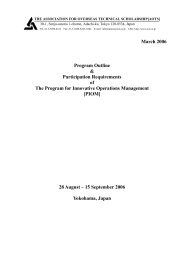Analysis of the Operation and Financial Condition of the Enterprise
Analysis of the Operation and Financial Condition of the Enterprise
Analysis of the Operation and Financial Condition of the Enterprise
Create successful ePaper yourself
Turn your PDF publications into a flip-book with our unique Google optimized e-Paper software.
<strong>Analysis</strong> <strong>of</strong> <strong>the</strong> <strong>Operation</strong> <strong>and</strong> <strong>Financial</strong> <strong>Condition</strong> <strong>of</strong> <strong>the</strong> <strong>Enterprise</strong>in order to make sure that <strong>the</strong> choice <strong>of</strong> a product is logical <strong>and</strong> substantiated <strong>and</strong> to searchfor <strong>the</strong> potential buyers.This is exactly <strong>the</strong> period when many firms go bankrupt. This is due to nonpr<strong>of</strong>essionalism<strong>of</strong> managers, inaccurate estimates <strong>and</strong> lack <strong>of</strong> working capital. If <strong>the</strong>seproblems are overcome <strong>and</strong> if <strong>the</strong> transition to <strong>the</strong> next stage is successful, usually <strong>the</strong>transformation <strong>of</strong> <strong>the</strong> inner management principles takes place from single management <strong>of</strong>a complex to its differentiation. This requires to devote more attention <strong>and</strong> at a morepr<strong>of</strong>essional level to planning, forecasting, risk assessment (not only intuitive, but alsoanalytical), long-term financial solutions, increasing <strong>the</strong> value for <strong>the</strong> owner investment.Development slows down during <strong>the</strong> stage <strong>of</strong> maturity, <strong>the</strong> market is considerablysaturated <strong>and</strong> competitiveness is determined by <strong>the</strong> lowest price. An enterprise mustreduce prices, search for business partners to stay in <strong>the</strong> market.Consumers have become even more dem<strong>and</strong>ing <strong>and</strong> <strong>the</strong>refore <strong>the</strong> quality <strong>of</strong> servicebecomes <strong>of</strong> more importance as well as <strong>the</strong> amount <strong>of</strong> sales to consumers needs to beincreased.There are strong market leaders who set market barriers for <strong>the</strong> newcomers. At <strong>the</strong>same time <strong>the</strong> weakest enterprises are leaving <strong>the</strong> market.During this stage active personnel management procedures are to be carried out,first <strong>of</strong> all, training, as it is <strong>of</strong>ten <strong>the</strong> case that <strong>the</strong> o<strong>the</strong>r resources, <strong>the</strong> employee potential,has been exhausted.An enterprise must stop purchasing products that do not bring <strong>the</strong> expected pr<strong>of</strong>it,by thus reducing <strong>the</strong> costs <strong>and</strong> focusing <strong>the</strong> attention <strong>and</strong> assets entirely on competitiveproducts. An enterprise may carry out takeovers <strong>of</strong> <strong>the</strong> weaker competitors, bringing <strong>the</strong>highest benefit to <strong>the</strong> enterprise, <strong>and</strong>, besides, this can take place <strong>and</strong> at considerably lowprice.Three notional categories <strong>of</strong> maturity may be attributable to this period in anenterprise (early, intermediary <strong>and</strong> late). The deepest concern in <strong>the</strong> work <strong>of</strong> <strong>the</strong> managersis associated with overcoming <strong>the</strong> first signs <strong>of</strong> stagnation <strong>and</strong> <strong>the</strong> excessive red-tape <strong>of</strong> <strong>the</strong>internal management processes.Within <strong>the</strong> stage <strong>of</strong> decline <strong>the</strong> dem<strong>and</strong> for <strong>the</strong> product is falling due to formation <strong>of</strong>an excessive capacity surplus in <strong>the</strong> industry, <strong>and</strong> <strong>the</strong> competition is being increased. Thismay be also affected by <strong>the</strong> external factors <strong>of</strong> <strong>the</strong> micro environment to <strong>the</strong> analysis <strong>of</strong>which larger attention must be devoted.An enterprise in its attempt to utilise <strong>the</strong> surplus capacities aims at reducing <strong>the</strong>prices which, on its turn, may cause price competition to occur. There is a dilemma nowfor an enterprise to consider – to leave <strong>the</strong> market or to continue operating in <strong>the</strong> sameindustry.As soon as competitiveness in <strong>the</strong> market is lost, inner conflicts arise, <strong>the</strong> financialindicators get worse. The struggle for survival becomes <strong>the</strong> main issue. However, <strong>the</strong> onlyway out for an enterprise at this moment is <strong>the</strong> readiness <strong>of</strong> <strong>the</strong> management <strong>and</strong> itscapability to achieve <strong>the</strong> realisation <strong>of</strong> new ideas.Portfolio analysis shows in a simple way <strong>the</strong> position in <strong>the</strong> competition <strong>and</strong> <strong>the</strong>attractiveness <strong>of</strong> <strong>the</strong> industry. If <strong>the</strong>re are several product groups in an enterprise,individual portfolio analysis has to be performed for each product group.13
















